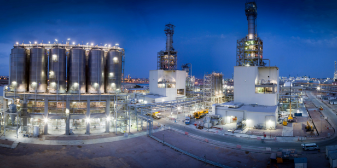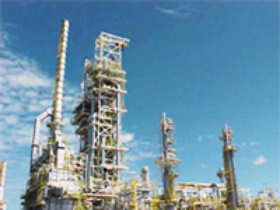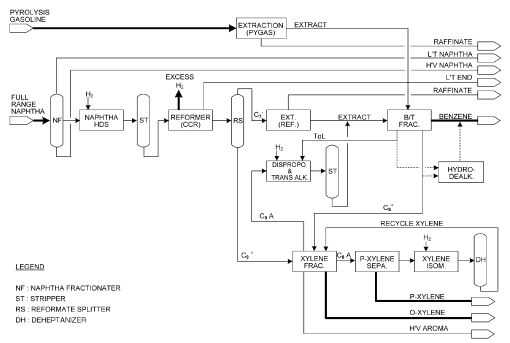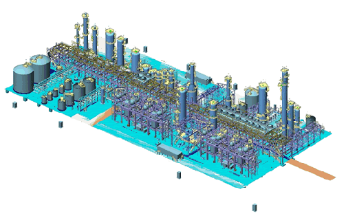

Polyolefin (PE/PP)
TOYO is an authorized bidding contractor for both the UNIPOL™ Polyethylene (PE) Process offered by Univation Technologies, LLC, and the UNIPOL Polypropylene (PP) Process offered by W. R. Grace & Co.-Conn..
Features
The UNIPOL Process is the first gas-phase process in the world to have succeeded to manufacturing PE in a variety of the range from LLDPE to HDPE. About 150 PE and PP production lines using gas-phase technology related to UNIPOL are serving the needs of the world’s polyolefin industry. UNIPOL is featured with a fluidized bed reactor to polymerize monomer (ethylene for PE and propylene for PP) in gas phase under a specific catalyst with a co-monomer and hydrogen. A solid particle bed is formed inside the reactor on which the polymer accumulates and is fluidized with the gas flow. There is no part mechanically moving nor a solid separation equipment like cyclone installed inside the fluidized bed reactor, This unique feature lowers construction cost and increases reliability of the production remarkably.
Experience
In 1989, TOYO was awarded the first UNIPOL PP plant in Indonesia. Since then TOYO has already delivered 24 PE plants and 8 PP plants in 12 countries over the world including one of the world largest PE plant of 800,000 kTA in Saudi Arabia.
※ UNIPOL is a trademark of The Dow Chemical Company ("Dow") or an affiliated company of Dow. W. R. Grace & Co.-Conn. and/or its affiliates are licensed to use the UNIPOL trademark in the area of polypropylene.
Aromatics
An aromatics complex is a combination of process units that can be used to convert petroleum naphtha and pyrolysis gasoline feedstocks into the basic petrochemical intermediates such as benzene, toluene, and xylene (BTX).
Features
Para-xylene separation process
The para-xylene separation process is the key process of a para-xylene production plant. Recently, adsorption processes are being applied worldwide, and the main licensors of these adsorption processes are UOP, AXENS and TORAY. TOYO has experience of design and/or construction of all these licensed processes. TOYO has also 3 (three) experiences of design and/or construction of transalkylation process which converts low value C9 aromatic hydrocarbons to xylenes

Separation process of an aromatics complex
The feedstock naphtha is first hydrotreated to remove sulfur and nitrogen compounds and transferred to the catalytic reforming unit, where the treated naphtha is converted to aromatics. The reformate from the catalytic reformer is sent to reformate splitter column. The C7- fraction is sent to the aromatics extraction unit for benzene and toluene separation together with the pygas feedstock. The toluene is fed to the transalkylation unit with C9- streams for additional benzene and xylene. The C8+ stream from the toluene column bottoms is sent to xylene column. The C8+ fraction from the reformate splitter is sent to xylene splitter, which overhead mixed xylene stream is transferred to para-xylene separation unit and produce high purity para-xylene. The raffinate from the para-xylene separation unit is sent to the isomerization unit where additional para-xylene is produced by equibrium reaction. The effluent from the isomerization unit is recycled to the xylene separation unit. If o-Xylene is produced in the complex, the xylene splitter bottoms is sent to o-xylene column and high purity o-xylene is produced.

Aromatics complex block flow
EO/EG (Ethylene Oxide/Ethylene Glycol)
TOYO has much experience of EO/EG plant construction.
Since TOYO constructed the first EO/EG Plant in Japan, which was licensed by Shell, we have constructed, sixteen (16) plants in various parts of the world. Most of those plants have been awarded in the last decade and it reveals the Customer's high reputation for TOYO's achievement in the construction of EO/EG Plants. EO/EG is raw material of polyester, etc. Major process technology can be summarized into three processes such as Shell, SD (Scientific Design), and Dow Chemical where most of EG is produced in the world. TOYO has the experiences in the construction with all three licensors, whereas most of the experiences are with SD technology.
The technology considering the energy saving and less investment cost and TOYO has contributed to the plant cost reduction of new plant by the application of our extensive experience.
In Saudi Arabia, three plants are in operation, and the largest 700,000 t/y plant in the world is under construction.
In July 2005, TOYO was awarded 700,000 t/y EG plant for Saudi Arabian company, utilizing the process technology by SD. In Saudi Arabia, 3 EO/EG plants constructed by TOYO are in operation.


